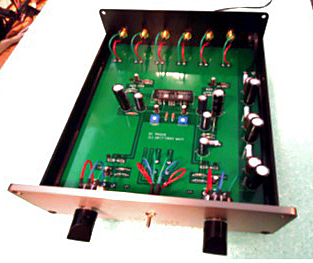First Watt Korg Nutube Preamp
Tip #105
Dick Olsher (April 2024)

A couple of months ago Nelson Pass asked me if I had listened to the Korg Nutube preamp which he had introduced at the 2017 Burning Amp Festival as a DIY project. Its main attraction is the Korg Nutube dual triode which can be successfully operated off a 24VDC power supply, albeit with a maximum output of about 3V which should be sufficient to drive most amps to full power. So, when I said I hadn’t, he sent me a unit for evaluation. According to Nelson, my unit was set for 1% 2nd harmonic distortion at 1 Volt output. The Korg goes into fairly high distortion at levels above a volt or two; it doesn't have the dynamic range of a regular triode.
The unit I received was in a B1 chassis and was hard-wired to a 24V/0.5A “wall wart” external switching power supply. This design, with updated PCB and a different chassis, is available from the diyaudio.com website. Pots on the kit version board allow adjustment of the plate voltage, which determines the amount of 2nd harmonic distortion and its phase.
From the Korg website: “Nutube, similar to a conventional vacuum tube, has an anode grid filament structure, and operates exactly as a triode vacuum tube. Also similar to a vacuum tube, it creates the same characteristic rich overtones. By applying their vacuum fluorescent display technology, Noritake Itron Corp., a Noritake Co. Ltd affiliated company, have devised a structure which achieves substantial power saving, miniaturization, and quality improvements when compared with a conventional vacuum tube.” The Nutube is sandwiched between two JFET buffers, the first one provides for a decent input impedance, while the second one provides for a low output impedance.
To be sure I had my doubts initially, as I'm usually not a fan of switching power supplies, and the 10 uF Elna Silmic II electrolytic coupling caps were also a concern. But to my surprise, the Korg impressed immediately with an addictive sense of immediacy. The midrange shined with tonal conviction (violin tone was superb) and excellent clarity born of soundstage transparency and image focus. It displayed solid-state virtues of transient speed and bass control combined with the soul of a tube stage. I tried both negative and positive 2nd harmonic (by reversing signal polarity before and after the preamp) and found the negative 2nd a bit smoother sounding, though I think that this may well be system dependent. But after extended listening I found the presentation to be overly sibilant, and that implicated the frequency range between 4 kHz and 10 kHz. So now I began suspecting the electrolytic coupling caps and/or the power supply.
Nelson told me that he didn’t expect much action on the supply, as the draw is very low, and since he had passively filtered it pretty well. But by now I had already purchased a completed diyaudio.com kit version with an external linear power supply off Audiomart, and it sounded much more refined in the upper midrange after I tweaked pots T7 and T8 to 10VDC. Eventually, I got around to snipping off the switching PS from the Korg B1 and replacing it with the linear 24VDC PS. This time I was surprised and shocked at the instant sonic improvement. Gone was the excess sibilance; hello smoother treble textures! I’m currently not bothered by the Elna Silmic caps; they do sound different than film types and exhibit some personality but that is not necessarily a bad thing. Bottom line: the Korg Nutube preamp is a brilliant design that manages to sound exceptional at an extremely affordable price.